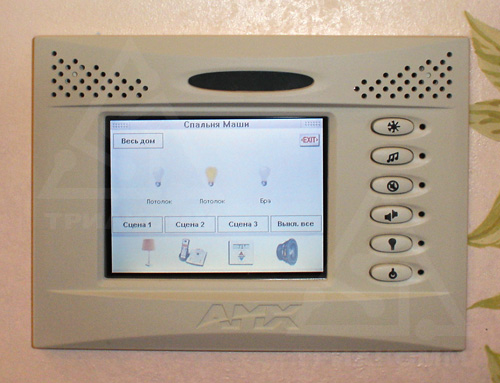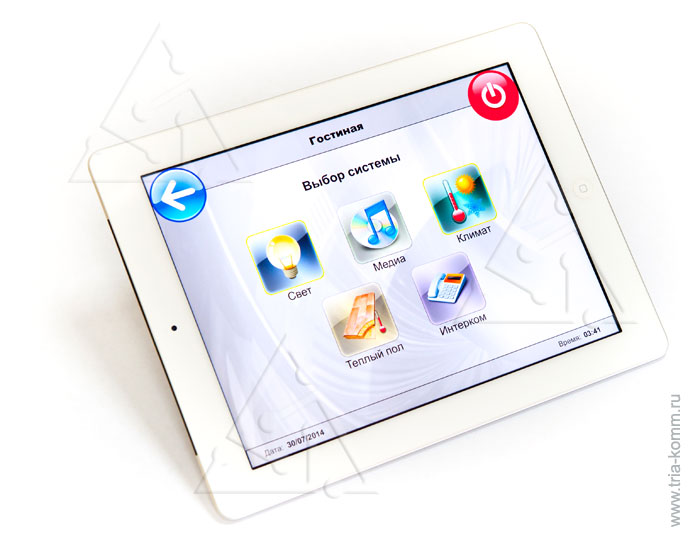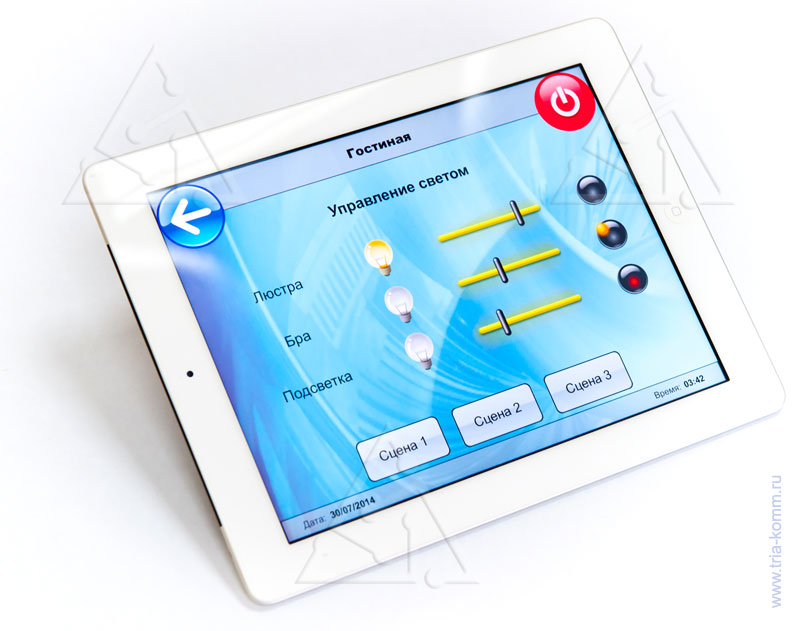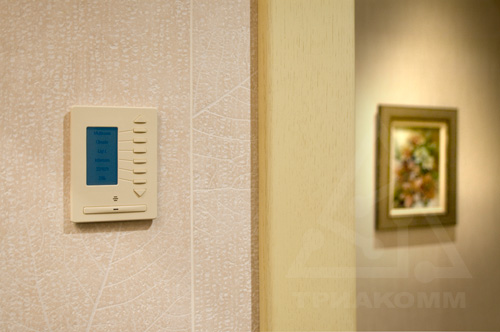Electric lighting control is perhaps the most trivial function of a smart home control system. Indeed, many companies offer the creation of lighting control systems and this function is almost the most key of its kind. But it seems to us that the integrated management of engineering systems is a more important task that a control system in a “smart” house or cottage should implement than simple control of turning the light on and off.
But still, let's get back to the control of light and the "smart" functions that it acquires in a "smart" home.
The light can turn on automatically when you enter the room and turn off when you leave. Those. smart home lighting reacts to your presence. For example, it is very comfortable and convenient to walk along a long dark corridor in which the light will “follow” you - turn on in front of you and turn off behind you. By the way, in this case we can talk about the functions of saving electricity, because. Lighting only works when you really need it.
You can control the lighting throughout the house or cottage using multifunctional touch panels with a convenient and intuitive control interface.

We also offer solutions that allow you to use your iPad as control panels.


It is necessary to mention the automatic switching on and off of the light according to illumination, time, sunrise and sunset, depending on the coordinates of the area. Even in the "smart" house, you can turn on the light everywhere with one button and turn off the light in the whole house or cottage, you can also use one button. This feature is very comfortable, convenient and really useful - try to go around and turn off the lights in all areas of a large house or cottage. This can take minutes of precious time, which is especially true when you are in a hurry somewhere.
Even in a smart home, you can implement many light scenes that allow you not only to comfortably spend your personal time in the house, but also to secure your home in your absence.
The lighting system with the control system will be able to simulate the presence of people, including various light scenarios in the absence of the owners. And if we add to this various options for light scenes to highlight interior elements, paintings, sculptural groups, facades, territory design, a winter garden, as well as the ability to smoothly adjust light from control devices, then the lighting control capabilities in a smart home will manifest themselves in a new light.

In short, it would be possible to list the possibilities of lighting control more. It's just that in your house or cottage with such a lighting system it will become more convenient and safer to live.
Lighting control from both panels and switches
We offer lighting control in a house or cottage using multifunctional touch control panels or using conventional standard electrical switches.

Thus, for example, if the main controller of the smart home fails, the light in the premises can be turned on and off using a conventional mechanical switch. Those. The lighting control systems we offer are very functional and reliable.
Our developments
To implement various functions of electric lighting control, our company uses devices of its own production.
*information posted for informational purposes, to thank us, share the link to the page with your friends. You can send interesting material to our readers. We will be happy to answer all your questions and suggestions, as well as hear criticism and wishes at [email protected]The human desire for comfort knows no bounds. An innovative development in the field of housing arrangement is the "smart home" system, created to save resources and create comfortable living conditions. Such premises imply automation of systems management:
- ventilation;
- conditioning;
- water supply;
- video surveillance;
- power supply.
Types and features of light control systems
To date, the most widely used classical lighting control system. It includes:
- single or multi-key switches;
- walk-through switches (lighting control from two points);
- cross switches (lighting control from three places);
- dimmer (mechanical or push-button) - a device for adjusting the brightness of lighting;
- motion sensors.
More opportunities in the process of controlling the lighting of an apartment give modern systems automatic control. With the help of programmable modules and controllers, all types of lighting fixtures. The system can be developed both for each room separately, and for the entire apartment as a whole. The system management process is carried out through:
- remote control;
- WiFi or GSM mobile phone or communicator;
- computer with remote access via the Internet.
Possibilities of automated lighting control systems
There are two ways to control lighting:
- Manual control implies the presence of a remote control, on which each button corresponds to a specific lighting device. It is used to turn on / off the lighting and adjust the brightness. This method implies the presence of remote controls for each individual room.
- Automatic control is carried out by installing motion sensors. The device detects movement and sends a signal to turn on the lighting. If there is no movement, the light will automatically turn off. This system does not exclude the presence of switches for manual lighting control.
In order to learn more about home automation systems for lighting systems on the website http://pro-smarthome.ru/lightmanagement, you need to pay attention to their additional features:
- Programming the lighting system of the apartment. Turning on and off the light occurs at a certain time according to the timer, in accordance with the automatic settings.
- Automatic lighting control using a light level sensor. At a low level of illumination (in the evening or during rain), the sensor automatically turns on the lighting and adjusts its brightness.
- The "presence effect" function during a long absence of the owners will create the appearance of a living space, alternately turning on the lighting in different rooms.
- You can focus on individual elements of the interior and create a unique image of the apartment using the “light scenes” function. The program prescribes the combination and brightness of lighting fixtures. The program memorizes several scenes, switching which is carried out at the touch of a button.
- The "running light" function is designed to illuminate the most passing places. Motion sensors react to the appearance of a person and alternately turn on the backlight, illuminating his path. Lighting elements are located near the floor and have a low glow intensity.
- Voice control of the lighting system. The system is programmed to execute certain commands after a sound or voice signal.
The installation of the lighting control system must be carried out by qualified specialists. An idle system in operation, at the design and installation stage, requires strict adherence to norms and rules, as well as taking into account all the features of the room.
MiMismart offers its customers incredible opportunities to control lighting in the Smart Home. Thanks to our solutions, you will be able to realize the most daring design ideas. Our company takes care of all lighting calculations, installation, selection of equipment, commissioning and creation of original lighting control scenarios in the Smart Home. You just have to enjoy the result of our work.
Capabilities
Uniformity. Forget about the many switches and remotes to control home systems. All this is now available from one touch panel or screen of your mobile phone (after installing the appropriate software).
Full control. With just one point of control, you can control the entire lighting system in your home, no matter where you are. If you have the Internet, you can turn on the lights in the bedroom from an office located on the other side of the city.
Zonal distribution. Lighting in the Smart Home is divided into zones that can be activated separately from each other. This can be a light controller in a bar, a kitchen area, additional lighting for the floor, walls, etc.
External light. Our specialists will install adjustable equipment for the external areas of the building. Surprise your guests with landscape lighting, facade lighting and outdoor area lighting.
Scenarios. Our company offers a wide range of ready-made default system management options. In doing so, you can customize your own version, which will include a unique set of actions.
Automatic control. This function is convenient because the lighting system in the Smart Home, using controllers and sensors, will automatically determine the required level of illumination depending on the time of day and year, human activity, the presence of people in the building, etc. In addition, you can implement light control by timer.
Additional Benefits
Autonomy. Thanks to motion sensors installed on the driveway and inside the house, the control system will automatically detect the approach of a person and turn on the light. Also, the lighting systems of the Smart Home are configured in accordance with your wishes. During the day, the lighting in the adjacent territory will be turned off, but with the onset of the evening it will gradually work brighter and brighter. Human participation is not required.
Saving electricity. You no longer have to think about whether you turned off the light in a particular room of the Smart Home. A motion sensor or reed switch will detect the absence of a person and turn off all lighting equipment. The universal scenario "I left" will allow you to turn off the lights throughout the Smart Home.
Light accompaniment. As soon as you enter the building, the light will turn on automatically and will follow you, turning off in the rooms you just left and turning on in the rooms you entered.
Binding to the multiroom system. RGB lighting can match with music. The lamps will shimmer or flash depending on the style of the song. This is a great ready-made system control option that is suitable for parties and children's parties.
Learn more about the lighting control system in the Smart Home by contacting MiMismart specialists in Moscow.
In our 21st century, when technological progress is developing incredibly fast, the smart home system is becoming more and more popular among the population. Of course, even today, not every homeowner has the financial ability to install such a system in their home. But as they say, everything flows and everything changes, any things that used to have a huge value are simplified thanks to mass production. If you look back 10 years, you can see that the smart home system was used only by very rich people. Over time, many elements and components of this system have improved, become cheaper, and today it has become available to a very wide contingent of users.
Possibilities of the "smart home" system video
The main purpose of this system is to control the lighting inside and outside the home. It must be understood that lighting in design, interior modern home plays today not just a huge role, but a key role, which is why it is necessary to pay special attention to this aspect. It is difficult to immediately understand all this and make the right decision on how to manage all these sconces, lamps and fixtures in the house. In this case, you will need a "smart home" - a very modern and very functional control system for external and internal lighting.
So, the smart home system solves almost all lighting problems. With this technology, you can control all light sources at the same time. In addition, by programming lighting scenarios, you will significantly save on electricity. The smart home system does not require supervision, it itself will offer a variety of lighting options. Technological progress has made accessible to all automated system lighting that does not require constant human intervention to function properly. Scientifically established that the right choice color combination can improve well-being or create a comfortable mood, both at leisure and at work. Since switching off and on lighting, adjusting color and brightness, everything in this system is automated, it seems that the house has a mind. This is where the name "smart home" comes from.
Read also: How to choose a chainsaw? Types of chainsaws
If we consider the scope of lighting control in and around the house, we can see that the primary responsibility of the lighting control system is to control the consumption of electricity . However, in addition to all other duties assigned to the system, there is one more, although not paramount, but important - it must fully comply with the design of your home, because the system is not only hidden elements - wires, contacts, etc. This is a set of outdoor elements that cannot be hidden.
So, if you want to change the usual vision of things, the color composition of the house, feel the cosiness in it and get a comfortable environment, which is so necessary for a person who is tired at work, then the smart home system is just what you need. You will have many options to control the light sources to get the right atmosphere. The system that controls the light has a lot of advantages compared to ordinary manual lighting. Let's find out what advantages an automated system has.
Advantages of the "smart home" system
The very first positive feature of a smart home in the area of interest to us is light brightness control , that is, you can change the brightness of the lighting as you wish. It all depends on what kind of atmosphere you need in this or that case: a family holiday or a party with friends, a romantic date or a business lunch. AT different time day for the human eye is pleasant and comfortable different level the glow of the lamps, the lighting should not be too dim, but at the same time not dazzling. What type of illuminators prevails in your home does not really practical value they are all adjustable. Smart House it is quite capable of changing the brightness and strength of light sources so unobtrusively and smoothly that the transitions will not be noticeable.
Read also: Choosing which boiler is better to buy
Control of light sources in one room or room is also on the list of advantages. The system is equipped with sensors for controlling the illumination of the room and does not depend on the indicators of the outside world. The room can be equally brightly lit, and it doesn't matter if it's raining outside the window or the sun is shining brightly. Or you can set certain rules, according to which the illumination will change during the day in the way you want.
A particularly interesting feature is the ability of the system to create a variety of light scenes and create your own script from them. You can change the parameters of not only one, but also several light sources at the same time, creating streams of light and illumination, which will change the interior dramatically in accordance with your mood.
Automatic turning lights on and off in the desired sequence - one of the most attractive features of a good smart home. The system includes motion sensors that are sensitive to the thermal radiation of a person, and when he moves around the house, the system reacts to his movement. Lighting turns on when a person enters the room, and accordingly goes out when a person leaves it. The system is designed for humans and when moving animals, the sensors will not work. At the same time, the smart home can remember the lighting mode that you used before leaving and, when you return, will restore the same level of light as before.
Read also: Household electric compressor: device and principle of operation, characteristics, selection criteria
I would also like to note that the system at dusk without your order illuminate the pool, walkway, garage or lawn . Naturally, the main thing is to program it correctly.
The system is quite complex, but it does not require any changes in the interior; if desired, it can be easily hidden in the walls. You don't need any special skills to manage it either. "Smart Home" is controlled by remote controls, and you can easily configure the system according to your own desires by pressing a couple of buttons.
Using the lighting control system called "smart home", you will become the real master of your home.
Share:
To build an automatic light control system in smart home bus technology is used, which has become the de facto standard in most European countries.
With this technology, all switches are interconnected by one trunk line - a bus. Thus, each switch comes not with the usual wires with a voltage of 220 volts, which then go to a light bulb (load), but a low-current cable with a voltage of 24 volts.
Traditional cabling requires more wires to be laid. After laying the wires, adding new switches or assigning other light groups to existing switches is no longer possible. With a bus-based organization, much less wiring is required. At any time, you can change the functions of the switch (for example, to control other groups of lights) or you can add a new switch.
Smart home switches are interconnected by this cable, and not necessarily in series. So from one switch, for example, standing at the entrance to the kitchen, one low-current cable can go to the switch in the living room, the other to the switch in the bathroom. Further, a low-current cable from the switch in the living room can connect several other rooms.
The general rules are usually like this.
- The low-voltage cable should start its journey from the electrical panel.
- The configuration by which the cable connects the switches can be almost any, with the exception of the "ring".
- The total cable length is limited by the capabilities of the selected bus technology system.
- The type of cable used must clearly comply with the recommendations of the system manufacturer.
The rules for laying such a cable and the connection diagram of the switches are indicated in the smart home project.
Now that all the switches are interconnected by a common bus, it remains to stretch the high-voltage wires along the ceiling from each group of light (load) to the same electrical panel from where the low-current cable began its journey.
Actuators - relays - are installed in this shield. From above, a wire from a separate group of light is connected to each relay, and from below these relays are connected in series with the same low-current cable. The next one is even easier.

In this figure, the control devices are switches and the actuating devices are relays. Depending on the manufacturer of the bus technology used, control devices can be combined with actuating devices. This is necessary for single solutions, when switching devices in the electrical panel is impractical due to long cable runs.
Each relay has its own email address. Each of the switches, in turn, also has its own email address. When a key is pressed on the switch, it sends its address to the bus. On the bus, the address reaches the electrical panel, where the relay with exactly the same address is activated (turned on or off).
To turn on or off several groups of lights at the same time (light scenario), it is enough to connect a device to the bus, which, by pressing one key, will send the addresses of several relays to the bus. Such devices are called scenario switches. Serious bus technology manufacturers have a rather impressive list of devices that can be supplied instead of conventional switches. These are lighting and motion sensors, smoke detection sensors, alarm system sensors, timers, thermostats, sensors, devices for controlling paired loads (curtains, blinds, awnings, gates), etc.
The general idea of bus technology is quite simple, but general rule usually like that.
- The purpose and types of email addresses for relays and switches must be specified in the relevant smart home system design.
- The calculation of the power of the relay installed in the electrical panel and its type should be carried out by a specialized organization.
- The relevant part of the smart home design (lighting control) must be carefully coordinated with the overall electrical design.
- It is better to entrust the selection of equipment, the assembly of a shield with electronic relays and the development of the entire smart home project to organizations that have a certificate for the right to install this equipment.




















